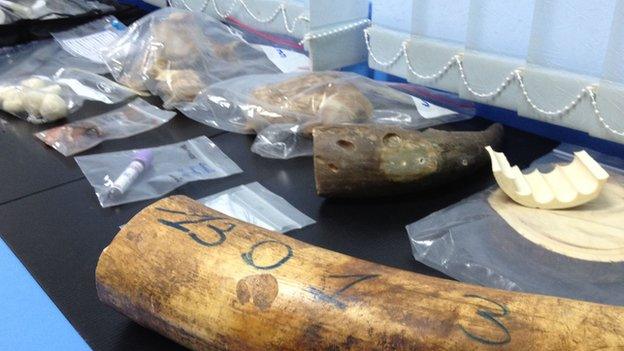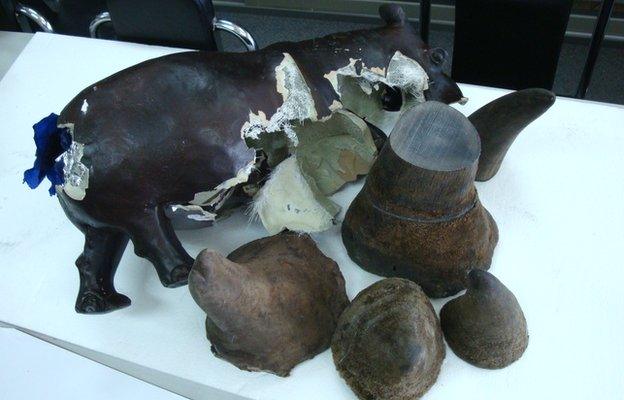Lab bids to combat species smuggling
- Published

Conservationists say only a sophisticated and intense campaign will help stop the slaughter of species
The latest forensic science is being harnessed in a bid to combat the international crime gangs killing and smuggling endangered species.
A new laboratory in the Thai capital Bangkok, equipped to gather DNA from elephant tusk, rhino horn and tiger skin, is on the front line in an increasingly desperate effort.
The move comes as wildlife trading moves into the major league of lucrative international criminal activities including the trafficking of drugs and weapons.
Rapidly growing demand for animal parts believed to have cultural or medicinal value has fuelled soaring prices and created greater incentives for poachers and dealers.
The lab's aim is to "prove the link between the victim and the suspect and support prosecutions", according to the scientists running the facility.
Conservation groups say the slaughter of elephant, rhino and tiger, along with other threatened species, has reached alarming levels and that only a concerted and sophisticated campaign will help.
Genetic database
The developments highlight the weakness of the only global agreement to halt the trade in endangered species, the CITES convention, set up 40 years ago. The latest round of talks on CITES opened in Bangkok yesterday.
The lab, located within the Thai Department for National Parks, was set up with the support of the specialist wildlife groups Traffic and Trace and the regional environmental organization ASEAN-WEN.
Its director, Dr Kanita Ouitavon, says the first samples of animals and animal parts have been analysed for their DNA and that a genetic database of Thai species is gradually being built up.
"It is very necessary to have new technology in my work - when we want to know about confiscated animals or animal parts, we can now find out about species or sub species or even learn about family links, the origins, where they're from and how they're related," she said.
"The illegal wildlife trade involves low investment but high profit and because no one owns the animals or the land it's so easy to commit the crimes.
See the scale of the smuggling problem and how the lab is trying to combat it
"So I can consider this lab is a useful tool to crack down on this trade. Using DNA can prove a link between the suspects and the animals."
The lab, with 10 staff, receives samples almost every week including segments of elephant tusk, rhino horn, entire tiger skins and pieces of fur and flesh from a host of other creatures.
Each sample is catalogued and photographed before extracts are run through a DNA sequencing process. For animal parts from outside Thailand, the sequences are checked against an international database.
Dr Ouitavon acknowledges that her team will need patience - and larger numbers of staff - to build up evidence against poachers and smugglers
She also highlights the reality of being a small band fighting some very powerful interests. The gangs are expert at securing support from within the authorities - for example, officers from The Royal Thai Police are regularly accused of aiding the trade or being involved in it themselves.
In fact, during our visit to the lab, news came through of the seizure, in southern Thailand, of a load of ivory in a van actually driven by a police captain.
Checks and balances
Dr Ouitavon is open about the challenge she faces: "We know from the beginning that those who are behind the illegal wildlife illegal trade are mostly influential and powerful people," she explained.
"If there is no check and balance like our unit so the problem will be worse… sometimes it may succeed or it may fail. That's not the main point. The important thing is we do it and we try to fight against it."
Customs officers also acknowledge that the Thai authorities have for years been notorious for turning a blind eye to wildlife smuggling, making Thailand an easy 'transit route' between Africa and China.
Now they insist that their procedures and intelligence have led to tightening up of controls, with better international cooperation, encouraged by the World Customs Union, and X-ray scanners to search cargo. Samples of hauls are now routinely sent to the forensics lab.
None of the customs officers wanted to be interviewed but they described a long list of recent seizures:
158 tusks from Kenya in crates labelled "handicrafts" intercepted in July last year;
A Vietnamese man, flying in from Ethiopia, with a suitcase full of ivory;
A consignment of 1099 ivory pieces, found in late January this year
The total haul of ivory between 2009-12 at Bangkok airport alone weighs about 7 tonnes and is valued at least $7m, they say.
The officers believe their clampdown is successful because the smugglers have been forced to try new routes. Rather than flying their goods directly from Africa, they are now routing it through the Gulf or Europe to try to avoid suspicion.
I was shown six crates packed with sections of tusk, all seized on a flight from Kenya. A total of 79 elephants had been slaughtered to produce this one sorry haul.

Samples from seizures arrive in the lab almost every week
The customs officer who led the operation seemed genuinely upset by it. The ivory, he said, "smells like a dead body" - it did have an intense musty odour and was a depressing sight.
But with more than 70 flights landing with cargo in Bangkok every day, maintaining a total screening is virtually impossible. I asked if the police would help them in the task, a question that produced a shake of the head and laughter.
Given the accusations levelled at them, I asked for a police response. Captain Marc Suranartyuth acts as a liaison officer with Interpol. He says he believes passionately in the need to fight wildlife crime and is clearly embarrassed by cases of police involvement.
"If I saw that I would feel really bad," he said, "since we are the government officials so we do our best to protect and serve people in our country and try to cooperate to solve crimes.
"That's why we want to solve the problem not create a problem."
Mary Rice of the Environmental Investigation Agency, an NGO specialising in wildlife crime, says one problem with international efforts is a lack of political will to tackle the biggest figures in the trade.
"They're catching foot soldiers and occasionally they're also catching the middlemen but to my knowledge they've never gone after the kingpins, the people driving the crime," she told BBC News.
"Since 2009 there's been a huge escalation in poaching and the current populations of elephants, for example, can't possibly keep up with demand."
Forensic science can play a part in saving species from extinction but only if governments are genuinely determined to stop the crime in the first place.
- Published12 July 2012
- Published12 December 2012
- Published9 September 2011